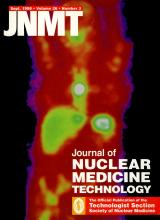Abstract
Objective: This investigation evaluated the effectiveness of disposable plastic inserts in radiopharmaceutical unit dose lead containers (pigs) in preventing the distribution of doses in blood-contaminated containers. Technologists commonly dispose of the syringes by placing them into the lead pigs, leaving the needles uncapped. This process raises the question of unsuspected blood contamination of these pigs. Consequently, the distribution of commercially prepared radiopharmaceutical doses in reusable lead pigs may result in radiopharmaceutical doses being distributed in containers that are contaminated with blood.
Methods: Using a simple chemical wipe test designed to determine the presence or absence of blood contamination, 618 pigs from commercial radiopharmacies throughout the U.S. were tested for contamination. The inside of the pigs and inserts, if present, were wiped before and after dose administration. Of the pigs tested, 292 came from radiopharmacies that used a protective, disposable plastic insert inside the pig, and 326 came from radiopharmacies that did not use an insert.
Results: Of those pigs without the protective disposable inserts, 39.3% arrived in the nuclear medicine department in pigs contaminated with blood. Of those pigs with inserts, 1% arrived with blood-contaminated inserts. After dose administration, 46.3% of the pigs without inserts were contaminated with blood and 3% of the protective inserts were contaminated.
Conclusion: The proper use of disposable plastic inserts reduces the possibility of distributing radiopharmaceutical unit doses in containers contaminated with blood.







